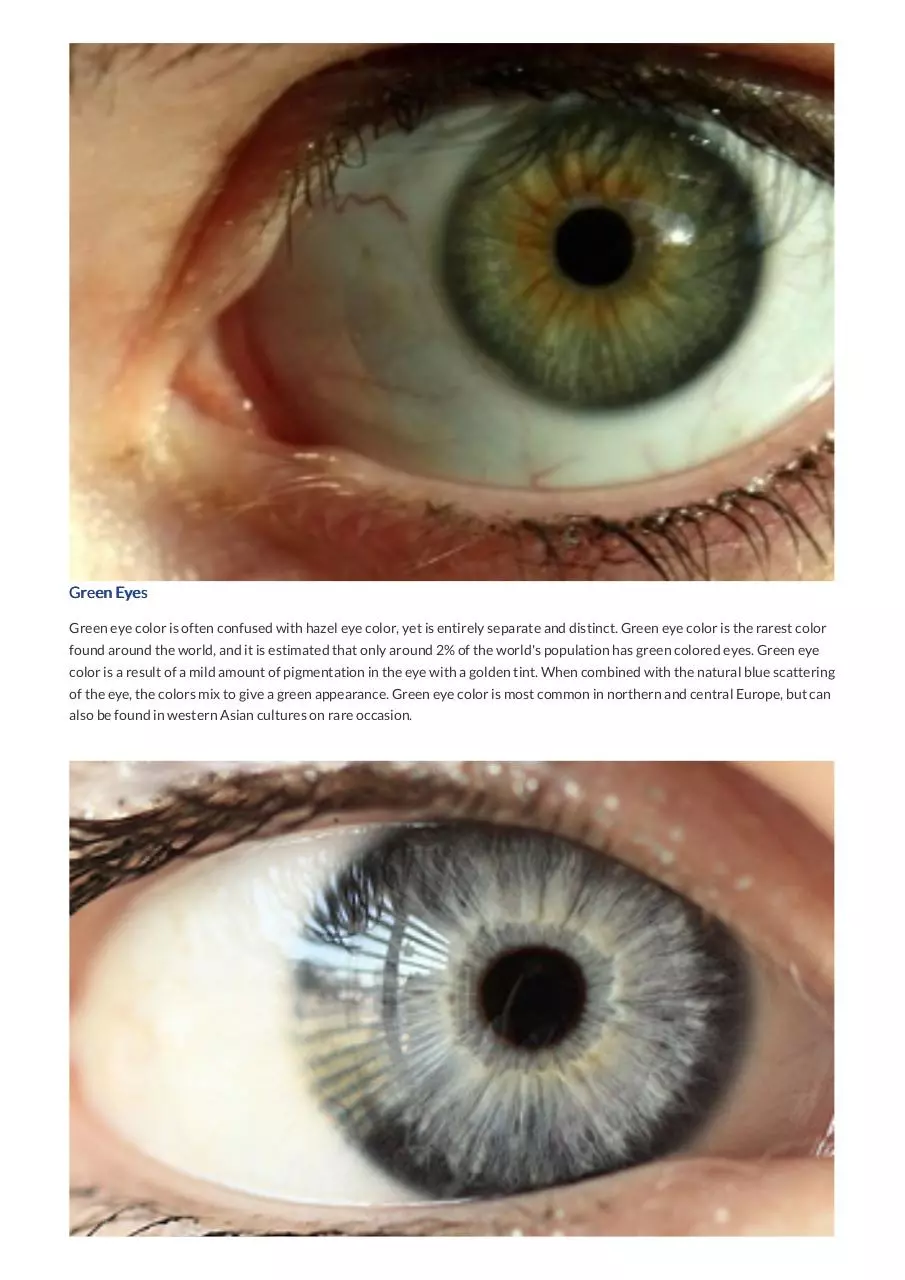eye color (PDF)
File information
Title: Eye Color Guide - The Most Common Eye Colors
This PDF 1.4 document has been generated by wkhtmltopdf 0.12.3 / Qt 4.8.7, and has been sent on pdf-archive.com on 20/11/2017 at 02:04, from IP address 124.170.x.x.
The current document download page has been viewed 1476 times.
File size: 207.07 KB (5 pages).
Privacy: public file





File preview
Free Shipping + Free Returns
Search
Eye Color Guide - The Most Common Eye Colors
The human eye is both beautiful and unique. Much like a fingerprint, each individual's eye color is specific only to them, with no
others sharing the same shape, color and appearance. So what eye colors are the most common, and which are the rarest?
W h a t
i s
t h e
m o s t
c o m m o n
e y e
c o l o r ?
W h i c h
Brown Eyes
Brown eyes are the most common eye color in the world with over 55% of the world's population having brown eyes. Brown
eye color is a dominant genetic trait, and is created by the presence of melanin in the eye. Over fifty percent of the world's
population has brown eyes, with nearly all individuals from Africa and Asia sharing brown eye color. Brown eyes are typically
darker than other eye colors, and they may even appear black in certain individuals.
e
Hazel Eyes
Hazel eyes are similar to brown eyes, although they are typically lighter in color, and have more of a green-yellow tint. Hazel
eyes have a higher concentration of melanin (pigment) around the eye's border, which can result in a multi-colored
appearance that varies between copper and green depending on the lighting. Most people estimate that around 5-8% of the
world's population has hazel colored eyes.
Blue Eyes
Blue eyes are genetically recessive, and therefore much less common worldwide. Blue eyes are formed by the absence of
pigments in the eye, where the blue color is formed by the scattering of light as it's reflected off the iris. While blue eyes are less
common than brown eyes, they are frequently found from nationalities located near the Baltic sea in northern Europe. It's
estimated that approximately 8% of the world's population has blue eyes.
Green Eyes
Green eye color is often confused with hazel eye color, yet is entirely separate and distinct. Green eye color is the rarest color
found around the world, and it is estimated that only around 2% of the world's population has green colored eyes. Green eye
color is a result of a mild amount of pigmentation in the eye with a golden tint. When combined with the natural blue scattering
of the eye, the colors mix to give a green appearance. Green eye color is most common in northern and central Europe, but can
also be found in western Asian cultures on rare occasion.
Silver Eyes
Silver eye color is also quite rare, although many consider silver eyes to be a variation of blue eye color. Like blue eyes, silver
eyes are the result of a very low amount of pigmentation in the eye, which reflects a gray-silver appearance. Silver eye color is
most common in eastern European countries, and is one of the rarer eye colors worldwide.
Amber Eyes
Amber eyes show off a yellow-copper tone, which results from the yellow colored pigment lipochrome. Amber eyes are very
rare worldwide, and are most common in Asia and South American countries. Amber eye color can range from golden yellow to
a more copper tone.
If there is one thing we can agree on, it's that all eyes are unique and beautiful. Additionally, thanks to colored contact lenses, it's
possible to change your eye color even if you were born with a common brown.
Also, make sure to check out our Freshlook Contact Lenses, which are the most popular, and most widely recommended colored
contact lens available.
Never miss a sale!
SIGN UP
Need Help?
Need Help?
Contact Us
Customer Support
Corporate Information
Customer Service
Our Story
Shipping
Terms of Service
Returns
Privacy Policy
HIPAA Notification
Affiliate Program
Accessibility Statement
Sitemap
Switch
Currency
ABOUT SSL CERTIFICATES
Download eye color
eye_color.pdf (PDF, 207.07 KB)
Download PDF
Share this file on social networks
Link to this page
Permanent link
Use the permanent link to the download page to share your document on Facebook, Twitter, LinkedIn, or directly with a contact by e-Mail, Messenger, Whatsapp, Line..
Short link
Use the short link to share your document on Twitter or by text message (SMS)
HTML Code
Copy the following HTML code to share your document on a Website or Blog
QR Code to this page

This file has been shared publicly by a user of PDF Archive.
Document ID: 0000698818.